Part I Bahia Honda Sporting Club
July, 2018: I get to fish the Florida Keys once every two or three years, and I remember each time I go, that our little piece of fishing heaven right here in the U.S. of A. is truly one of the world’s best flats fisheries. Whether its tarpon, bonefish, or permit you’re pursuing, you’ll find them in good numbers, and, you’ll have the opportunity to seek out trophy-sized specimens as well. The convenience of domestic flights, a great guide pool, and a plethora of accommodation choices, make the Keys a destination worth considering when planning your next trip to the salt.

When I received an offer from Bahia Honda Sporting Club owner, Gordon Baggett to come down and see what his lodge had to offer during prime tarpon season, I jumped at the opportunity. A quick check of the 10-day forecast confirmed that the stars were aligning for what hopefully would be an epic trip. The dates, moon phase, and tide schedule looked like they were going to coincide with a phenomenon called “the worm hatch,” a once-a-year “hatch” of the Palolo worm, a reddish-pink worm-like organism that hatches by the tens of thousands on certain late afternoon tides, making the tarpon giddy with an excitement fueled by easy pickin’s. While the majority of tarpon caught from Bahia Honda Sporting Club (BHSC) are caught outside of this short time period it’s still fun to have had a chance to experience it.
I landed in Key West around one in the afternoon via Newark on a terrific schedule out of Portland, Maine. Gordon picked me up and took me to his villa on the waterfront where I dropped my bags, grabbed a quick lunch, and jumped on a skiff to take advantage of a half-day of fishing. One of the things that makes BHSC so special is its proximity to the best tarpon fishing flats in the Keys. I was scanning the flats for tarpon within five minutes of leaving the dock. My guide, Danny Lynch, and I were discussing the typical travel patterns that the fish tend to like on this particular flat, specific to the tide we were fishing. He was telling me that they liked to approach from our left for the most part but then said “sometimes they’ll come in fro — one o’clock 60 feet coming from right to left, two fish”. I was like “wait, what?” Talk about jumping right into it. My first cast was rewarded with an epic take from the second fish as it waffled my fly. When it felt the bite of the hook, it immediately went airborne and proceeded to dump about a hundred yards of line from my reel, putting on an aerial show that lasted about 15 minutes until surrendering boat side for a quick pic and healthy release. We were both laughing at the crazy luck we had just experienced, and I couldn’t help but feel that I was on my way to a tarpon trip of a lifetime.
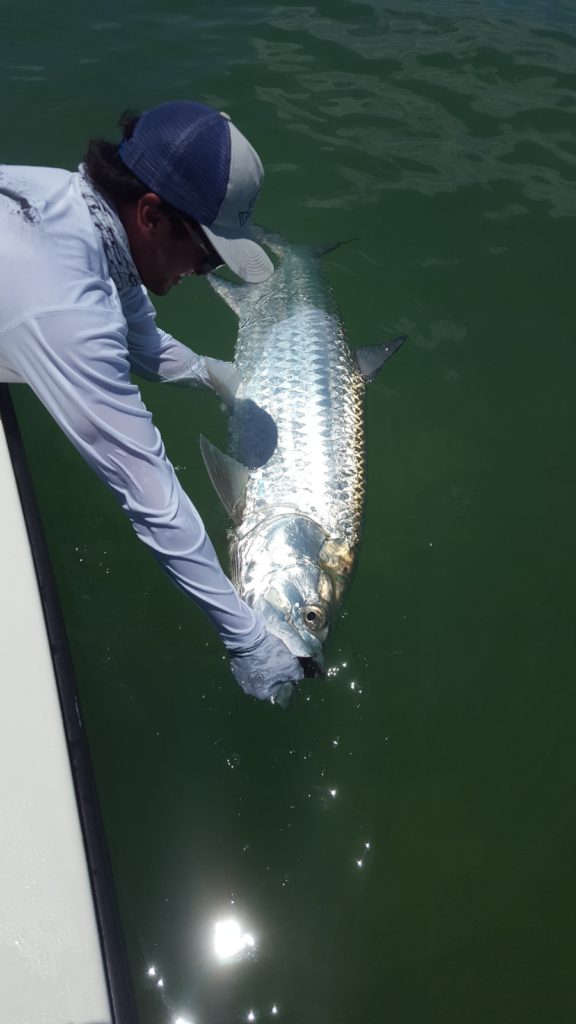
We got a few dozen more good shots before jumping off a small fish and calling it quits for the day. We headed back to the villa for cocktails and a fantastic meal prepared by culinary wizard Chef William Hunt. One of my good clients, Rick Cobb, was in-house during the week with his father and brother in tow. It was their first foray into fly fishing for tarpon. Rick had a great first day, landing a couple of really nice fish including one of around 130 pounds, a great way to indoctrinate himself into the addictive world of tarpon fishing. I’m already busy locking in his dates for next year’s trip.

The sobering reality of fly fishing for tarpon set in on day two, fishing with Ryan Brewer as my guide. Let me be clear from the get-go, when I give you these numbers I am not exaggerating, so please don’t roll your eyes and give me the ole “ya sure.” Day two had me jumping off one fish, pricking another one just a little, and getting four eats that didn’t take hold. That isn’t really all that bad for a day of tarpon fishing, but when you consider that I cast to close to a hundred fish, it puts things in perspective. I simply could do nothing right. All-day long I continued to frustrate myself with poorly placed casts, forgetting about the subtleties that matter like wind direction, tidal movement, etc. I’d cast too early, the fish would change course, I’d cast too late, and the fish was too close to the boat. I’d cast it just right, and the fish would give me the middle fin. You name it, and I did it wrong for an entire day. It is purely painful to relive it. It’s not that I can’t cast well, I just didn’t. Ryan might be the most patient and positive guide that I’ve ever fished within my life. My dreams for the epic tarpon trip were falling into doubt as memories of past tarpon failures replayed in my mind as the nightmares of a pastime that can be unforgiving at best. I needed medicine after this one, and I’m not ashamed to say I found it in the form of Makers and ginger back at the bar.

I’ve neglected to tell you that the weather, while I was at BHSC, was some of the best I’ve ever had in over 35 years of flats fishing. Mid-80’s and sunshine with a 10 mph breeze (without which we probably would have sweltered). It is the weather that every tarpon fisherman dreams of having. Day three was no different, and as I walked to the dock, I was thinking to myself that day two’s miserable performance came with absolutely zero credible excuses. I owned it and moved on. Jumping in the boat with Jimmy Welch for day three, I confessed my sins of yesterday, and wished him the best for our upcoming day, making sure the expectations he might have for me were properly set.
Ten minutes into the morning we had fish coming at a steady pace from all directions. Plenty of good casts coupled with refusals were the norm for the first hour, so there was a glimmer of hope for a rebound day. Then, we connected with a fish of around 70 pounds or so that popped off the boat side as we were landing it, taking the loosened top section of Jimmy’s G. Loomis rod to the bottom of the flat never to be seen again. Sorry, Jimmy. A quick call to Loomis and a replacement was on the way, and we resumed fishing.

We watched as tarpon fishing legend, Andy Mill patiently scanned the waters for tarpon on the same flat we were fishing, a nearby second skiff filming him for a soon-to-be-released promotional video. Jimmy called out a fish at 11 o’clock 100 feet and closing slowly, riding high in the water just like you dream about. I waited to cast until the fish was about 50 feet out, and stripped the olive-colored Toad pattern seductively as the fish approached. She ate it with a vengeance uncalled for in such a mismatched predator/prey scenario, similar to a mountain lion attacking a mouse. It was like looking into a deep dark cave as the fly disappeared and the big female tarpon turned downward. When she felt the hook hit home, she simply left for mile-marker 36 on Route 1 in the distance. She freight trained it straight away, never once stopping to go airborne, which in hindsight was probably a good thing. With the drag on the Abel reel tightened down hard, she peeled off a steady 200+ yards of backing from the puny 10 wt. the outfit she was tethered to. I straight-sticked the fish the entire time, a technique where the fish is fought not with a bent rod, but only with the reel’s drag and the stoutest portion of the rod in play. She split the two boats on the flat ahead of us and took us into the water of fewer than two feet in depth. It was then I realized just how big she was as she moved a ton of water with each beat of her tail. 50 minutes later she was boat side and being revived. We took some pics and released her, Jimmy and I smiling at each other in disbelief at the size of the beast we had just landed. This was by far the largest tarpon I had ever caught in my life. It wasn’t until after I had a chance to view the images that I realized just how massive she was.

Day 4 arrived, and I fished tarpon for a half-day and tried my hand at permit for an hour or so. We cast to many fish on both sides of the slack tide and garnered no interest from them. The same could be said for the permit, though to be fair, we were not able to devote much time to that pursuit. The thing that struck me most was the sheer number of tarpon we saw over four days. Without exaggerating, I would say we saw close to a thousand fish, and the number of good opportunities we had would satisfy even the most selfish of anglers.
In summary, if you’re looking for a place that provides top-notch opportunities for sight fishing tarpon in shallow water, a place where accommodations are premium, and a place where the cuisine is on par with the fishing, look no further than Bahia Honda Sporting Club. Prime dates for the 2019 season are still available, and they’re looking at a schedule that starts in mid-May and concludes in mid-July. Give us a call, and we’ll help secure your spot.
Part II The Eleven Experience Liveaboard – Marquesas Islands
After bidding farewell to the crew at BHSC, I headed to Key West City Marina for my boat transfer to join our friends on the Eleven Mothership, anchored at the Marquesas Keys about 40 minutes off Key West. Beason Huffman, first mate, charter boat captain, and all-around handyman met me on their 26-foot Regulator for the water transfer out to the islands. I had not been to the Marquesas for nearly 25 years and was anxious to fish its pristine waters once again. Although my time was limited to a day and a half, the weather forecast remained the same, and my expectations continued to be high.
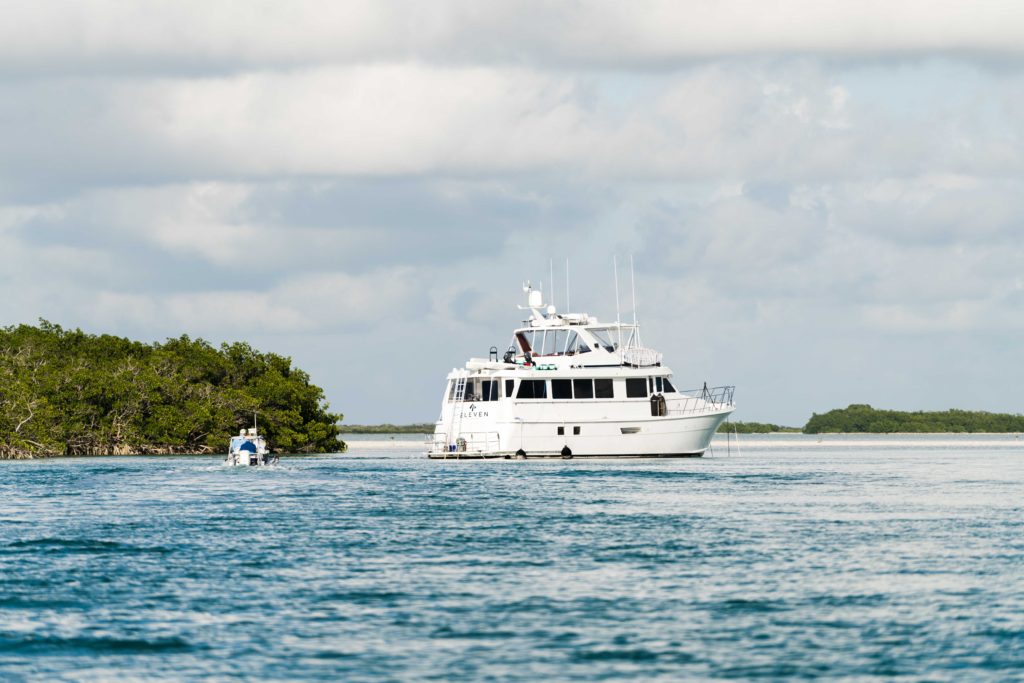
I was greeted on the aft deck by the affable Captain Tony Valentino, Chef Penny Dabastani, and flats guide Jerry Perez. Having taken the morning off from fishing back at Bahia Honda, I was anxious to get back out on the water, so Jerry and I quickly loaded the skiff with some beverages and headed out on a short run to the first flat, a mere 10-minute boat ride away. I was a bit surprised that at three in the afternoon we found that we had the entirety of the Marquesas all to ourselves, a rarity in the month of June especially when all three of the slam species are present in good numbers. I guess it’s somewhat expected though as most of the people fishing the Marquesas are day-fishing out of Key West, and the journey out and back requires close to an hour’s time, longer if the Boca Grande channel is catching a stiff breeze and the tide is strong; some days are just impassable. Also, most guides are on an eight hour day. This is where the mothership option offers a premium advantage for anglers wanting to fish this area; first on the flats and last off of them, and no eight hour days. You’re there when the sun rises and when it sets, giving you at least an added four hours of fishing time over those making the daily run out. That’s a lot of time, and most of it is prime fishing, even with the low light.
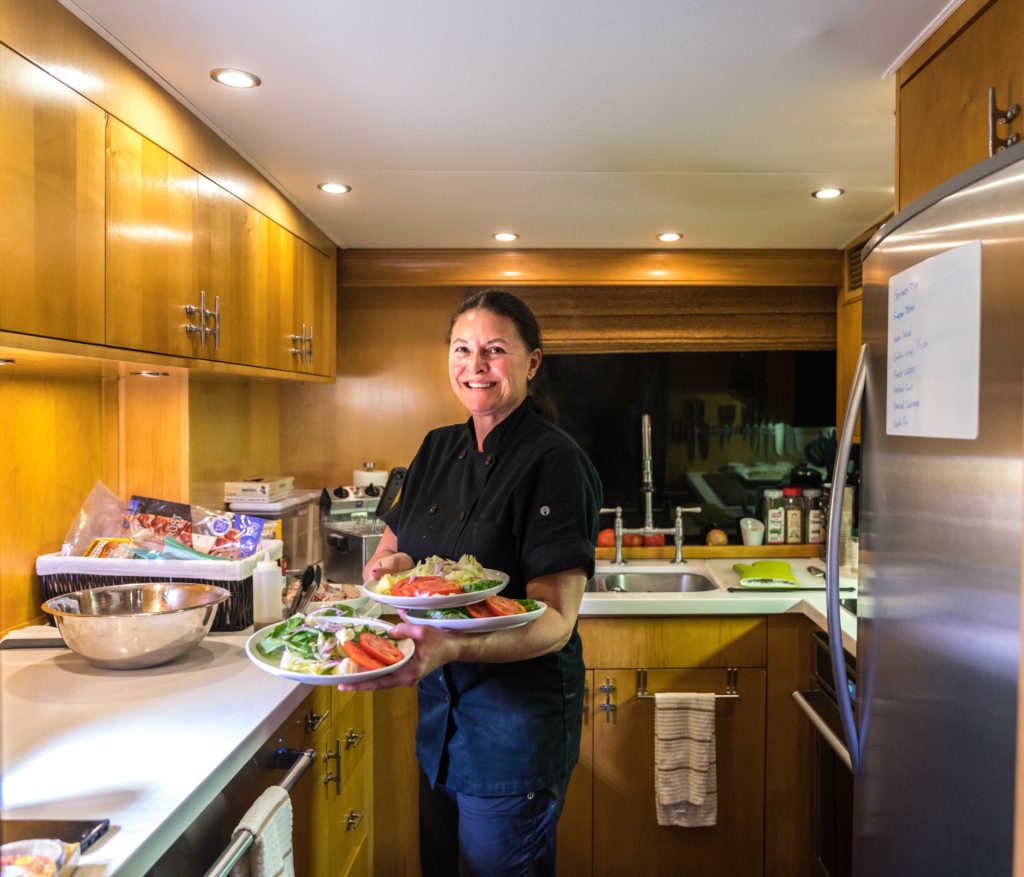
We cast to many schools of fish, jumping off a pretty good fish of around a hundred pounds before heading back to the ship and settling in with cocktails and a fantastic dinner prepared by Miss Penny, who also shared with us stories that made us laugh until our bellies ached. It was a great way to end my first day aboard the Eleven.
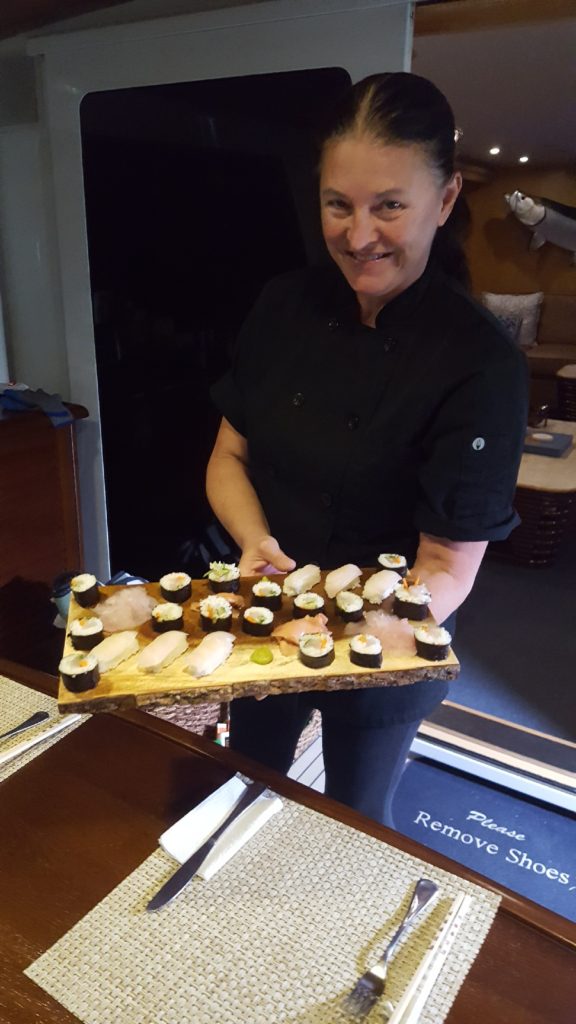
On day two, a gentleman’s start at 8 o’clock was just what the doctor ordered. After a great breakfast Jerry, Beason, and I headed out to search for fish. With a soon-to-be slack tide we found that fish movement was moderate in comparison to when we had a good tidal push, and although we were in fish most of the time, they didn’t seem to be in the eating mood. We returned to the boat for lunch and a siesta, heading back out on the water around three in the afternoon. It took us about a half-hour to find the fish, and from then on it was lights out. Huge wads of fish were all over the place, swimming and daisy-chaining in groups of ten to two hundred fish at a time, providing one of the coolest fishing experiences I’ve ever witnessed. Thus began the “pick a fly” scenario. We presented flies to fish about ten or fifteen times, changed flies, did it all over again, and finally, we hit the reset button and picked out a palolo worm pattern. The third cast was a charm and Beason and I took turns feeding these fish until it was almost dark. Two break-offs (we were fishing down to 40-pound shock tippets), and four jump-offs, one an absolute sea monster of around a hundred and fifty pounds. It was incredibly fun and a fantastic, memorable way to cap off a trip-of-a-lifetime for me.
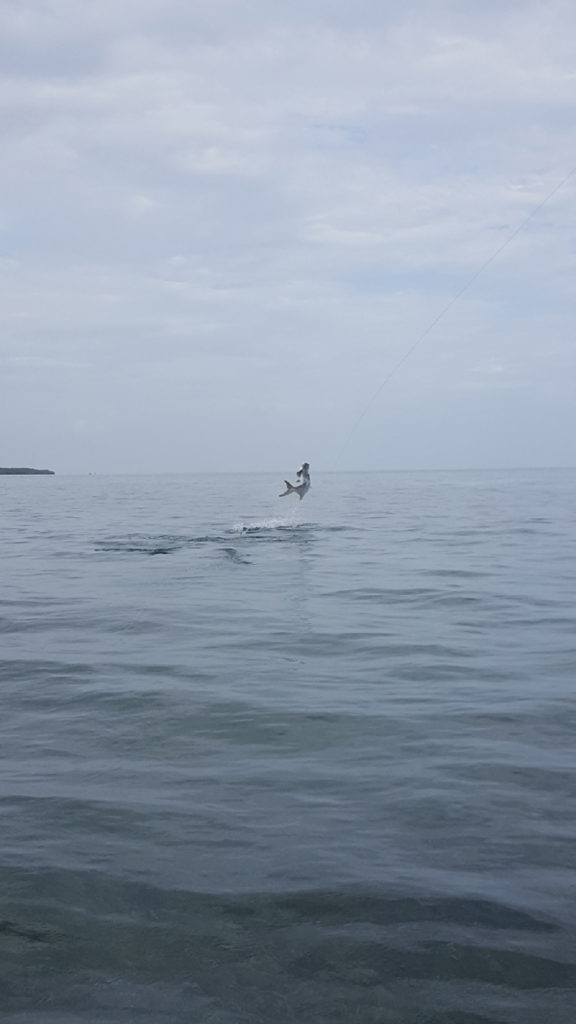
In Summary
It’s all right here; easy access via either Miami/Ft. Lauderdale or dropping directly into Key West. Some of the best fishing I’ve ever experienced in my life, just a few hours from pretty much anywhere in the U.S.A. Bahia Honda Sporting Club – Luxury accommodations, great cuisine, superior guide staff, and easy access with one of the world’s best tarpon fisheries at its doorstep.
The Eleven Mothership – a unique fish-til-you-drop experience in one of Florida’s truly wild and exotic environments; superior dining, comfortable accommodations, great guides, and a truly unique way to fish one of those magical places, just a hop skip and a jump from home.
We would be happy to arrange a trip to either venue for you, or, we’d be happy to couple both trips into one great experience where you can enjoy a land-based lodge with a live-aboard operation just like I did. Give us a call to help plan your next great adventure in the Florida Keys.
By: Joe Codd



